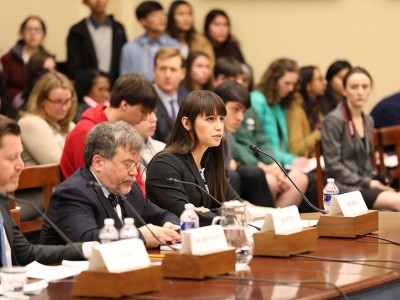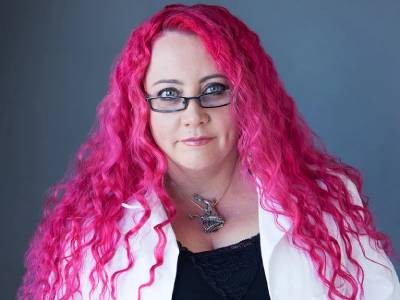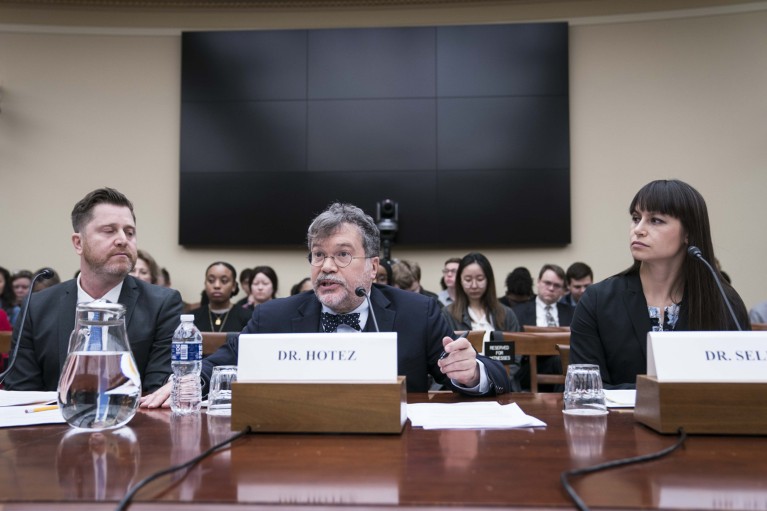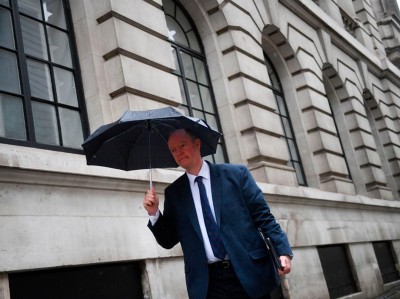As a vocal advocate of vaccinations for public health, Peter Hotez was no stranger to online harassment and threats. But then the abuse showed up on his doorstep.
It was a Sunday during a brutal Texas heatwave in June 2023 when a man turned up at Hotez’s home, filming himself as he shouted questions at the scientist, who is a paediatrician and virologist at Baylor College of Medicine in Houston, Texas.
Because of the long-running online and real-life abuse he has faced, Hotez now has the Texas Medical Center Police, Houston Police Department and Harris County Sheriff’s Office on speed dial, an agent tasked to him from the FBI and extra security whenever he speaks publicly.
“This is a very powerful adversarial force that is seeking to undermine science, and now it’s not only going after the science. It’s going after the scientists,” he says.
Hotez is an especially well-known scientist, but his experience is far from unique. Every day around the world, scientists are being abused and harassed online. They are being attacked on social media and by e-mail, telephone, letter and in person. And their reputations are being smeared with baseless accusations of misconduct. Sometimes, this escalates to real-world confrontations and attacks.
‘I hope you die’: how the COVID pandemic unleashed attacks on scientists
Such threats to scientists aren’t new; those researching climate change and gun control, for example, have endured abuse for decades. However, since the start of the COVID-19 pandemic, there has been an unprecedented escalation in the intensity and frequency of attacks, and the range of targets, say researchers. Anthony Fauci, the former director of the US National Institute of Allergy and Infectious Diseases and one of the most high-profile infectious-diseases specialists during the pandemic, was subject not just to online trolling, but to two credible attempts on his life that prompted the arrests of two people. Virologist Marc Van Ranst at the Catholic University of Leuven in Belgium and his family were moved to a safe house after a far-right soldier hunted them.
It’s not just scientists with a public profile in the crosshairs; those targeted include mathematical disease modellers, pharmacologists, physicists and fluid-dynamics researchers, who have never previously had any media attention.
“You don’t even necessarily have to be someone who’s active on social media,” says Sarah Sobieraj, a sociologist researching digital abuse and harassment at Tufts University in Medford, Massachusetts. “The visibility that brings attention to you could come from any number of sources that are not of your own doing.” Scientists have been attacked for private lectures and conference presentations that are shared online, studies published in journals, research work done for government agencies and even private Facebook posts shared publicly without their consent.
Researchers say that the surge in abuse is showing no signs of slowing down, even as the pandemic itself slips from the headlines. “All the data that we do have points to it increasing rather than decreasing; it’s certainly getting quite prolific,” says Lyndal Byford, director of news and partnerships at the Australian Science Media Centre in Adelaide. “I’m hearing a lot from universities and research organizations that they’re seeing it as an increasing problem.”
However, universities and research institutions are often slow to respond to this fast-moving threat, and the support they offer can frequently fall short, say many researchers who have experienced harassment. “Too often, we’re off on our own, not getting the backing of the institutions,” says Hotez.
Microbiologist who was harassed during COVID pandemic sues university
This issue has led to a court case in New Zealand, in which microbiologist Siouxsie Wiles is suing her employer, the University of Auckland, over the way it has responded to the ongoing harassment she has experienced since early 2020, which included online attacks and people confronting her in public. Wiles’s lawsuit alleges that the university “failed in their duty to keep her safe in her employment”. (The university says that it took numerous steps to ensure Wiles’s safety.)
The lawsuit and other high-profile cases have prompted a broader discussion among researchers, universities and other organizations about how best to respond to this kind of harassment. There is a growing recognition that online abuse and other types of attack can cause serious harm to individual scholars and to universities and research institutions. If researchers can’t communicate openly without facing abuse, “then really one of our core missions is being quite substantially damaged”, says Emma Johnston, a marine ecologist and deputy vice-chancellor of research at the University of Sydney, Australia.
Supporting scientists
Public-health researcher Tara Kirk Sell at the Johns Hopkins Bloomberg School of Public Health in Baltimore, Maryland, became a target for online harassment and abuse after she started appearing on conservative television networks at the start of the pandemic in 2020 to talk about COVID-19. She and her colleague Beth Resnick, also a public-health researcher, decided to look into how many other people at Bloomberg were experiencing harassment; Sell was far from alone.
“We’re lucky,” says Sell, about the supportive leadership at their institution. The researchers were asked if they had any ideas about how to tackle the issue. So they put together a working group of people from across the university, and interviewed people who had experienced abuse to find out what could help.
“The most important thing really is that people feel like their institution supports them,” Sell says. The challenge is getting that support to them quickly and easily, with as few barriers to access as possible.
The approach they chose was to set up a dedicated e-mail address that staff can forward messages to if they receive abusive communications or posts on social media. That triggers an automatic alert to the campus security team as well as to Sell and Resnick. The staff member gets an immediate automated response with information about institutional support they can access, including counselling, the communications team and emergency-contact details for the security team.
Security will automatically get in touch with the affected person in two business days. Sell and Resnick also personally contact the staff member to make sure they’re all right.

Researchers Peter Hotez (centre) and Tara Kirk Sell (right) at a congressional hearing in 2020.Credit: Sarah Silbiger/Bloomberg/Getty
That ‘one-stop shop’ approach is crucial for dealing with online abuse and harassment, says Byford, because otherwise people facing these problems are at risk of falling between the cracks of organizational structures. “Everybody sees that it’s a big issue, but it’s not always clear who within that university structure is the right person to take control,” she says.
A multi-disciplinary team approach is key for handling harassment, says Bram van der Meer, a threat-assessment specialist at Dantes Psychology Services in Voorburg, the Netherlands, which works with organizations to manage problematic workplace situations. Van der Meer calls these groups ‘social-safety expert teams’ and says they should include people from various departments such as security, human resources, legal and university leadership. Such teams would have expertise and training in swiftly triaging threats and deciding on the best course of action, while also supporting an individual who is on the receiving end of the abuse.
But social-safety expert teams are no use if people don’t know about them or are hesitant to report to them. “There has to be a lot of advertisement about the existence of this group,” van der Meer says. He suggests that the university have an ambassador for the programme, who can help to raise the profile of the support service and encourage staff to make use of it.
Often people delay reporting harassment — or don’t report at all — until a situation escalates. Van der Meer says one of the most common reasons for this is that individuals are worried about the professional consequences of raising an issue, such as what their colleagues will think. They also worry that they are overstating or exaggerating the problem.
Sobieraj says women are often wary of reporting abuse and harassment, because they don’t want to be perceived as being ‘whiny’. The material itself can also be embarrassing to talk about. “If somebody has sent you a doctored image of yourself that’s pornographic or the commentary is talking about your presumed sexual behaviour, this is kind of embarrassing to talk about, or humiliating,” she says.
But under-reporting can hamper an institution’s ability to build a true picture of the problem and understand how serious or widespread it is. “I only see when one person e-mails me,” says Sell about receiving a harassing message. ”But I don’t know if that person’s e-mailing 50 other people in the department.”
Knowing about shared experiences also has its benefits. Johnston says the University of Sydney has found that being able to speak to others who have gone through the same thing can help those who are experiencing abuse. “They know that they’re not alone, and they form their own support network, they can share best responses and resilience tricks,” she says.
Online abuse and harassment is isolating, and can lead to serious psychological and professional harm, particularly for individuals who are already vulnerable or at a systemic disadvantage, says Alice Marwick, a communications researcher at the University of North Carolina at Chapel Hill. “People who are first-generation academics, or people of colour, or queer folks or women, these are already people who are bearing enormous burdens.”
Marwick thinks that abuse is discouraging researchers from working on certain subjects that might attract unwanted attention. “I think that there’s a lot of people who are interested in studying controversial topics who don’t want to study them because they’re worried about this kind of backlash,” she says. She and her colleagues have published a guide to help researchers and academic institutions deal with harassment (see go.nature.com/4dhsxv4).
Tailored strategies
The stereotype of an Internet troll has long been of a lone individual hiding behind anonymity. But as Hotez’s experience has shown, the harassment can come from all levels of society. Sometimes it comes from other academics, even at the same institution. Sometimes it can come in the form of spurious complaints of research misconduct made through official channels.
Such attacks warrant different strategies that might include a public statement of support from the scientist’s institution. “We put out statements in support about academics’ right to present their work, free from harassment, and the right to present their expertise,” says Johnston, although she adds that the university doesn’t take a political stance or position on the topic at issue.
And releasing a statement of support can be complicated if the attacks come from the political sphere, because universities, funding bodies and other scientific institutions are expected to remain politically neutral. During the pandemic, scientists in the United States often came under criticism from right-leaning politicians, which led to cases of harassment.
COVID scientists in the public eye need protection from threats
In the United States, says Hotez, “the aggression against science and scientists is coming from one political party, and the extreme element of one political party”. So when scientific institutions remain neutral, that policy “favours the tormentors”, says Hotez. “More often than not, the scientists are kind of hung out to dry.”
Politically motivated harassment has happened in other countries, too. For example, supporters of Brazil’s former president Jair Bolsonaro tried to sue microbiologist and science communicator Natalia Pasternak for her criticisms of the Bolsonaro government’s response to COVID-19. In New Zealand, far-right activists opposed the government’s actions during the pandemic, and scientists involved in COVID-19 research. “We saw coordinated, targeted, networked abuse,” says Natalia D’Souza, a consultant on cyberbullying and cyberabuse, and board member of Netsafe, a non-profit organization focused on online safety in Auckland, New Zealand. “What comes to mind is particularly alt-right groups, who co-opt research either to serve their own agenda or to attack and discredit research and academics themselves.”
Spurious complaints of misconduct are another challenge for scientific institutions to manage. Johnston says the University of Sydney takes all complaints seriously and will follow standard policies and procedures in the first instance. But if there are repeated complaints by or against the same individual, and no new material is provided, the university will ask the complainant to cease and desist. “We can also send messages to key people who have received this information, that we’ve done a full investigation and we have found no substance to their complaints,” she says. “That’s a proactive measure to help protect their reputation.”
It can be particularly difficult to deal with harassment that comes from, or is prompted by the comments of, another academic. “Some of the most impactful abuse and harassment comes from peers and colleagues,” Byford says. It’s also been a source of frustration for Hotez, seeing his equally respected peers spreading what he sees as disinformation.
Geneticist Jack Heinemann at the University of Canterbury in Christchurch, New Zealand, who was an expert witness for Wiles’s case, says that academic freedom does allow people to be wrong, as long as they don’t use defamatory language or promote violence when criticizing others’ work. “The most appropriate way to deal with somebody who is squarely within their academic freedom is to use your academic freedom to confront them.”
But Heinemann argues that university researchers who are communicating about their field of expertise should be supported and protected while doing so, rather than being cloistered or advised to limit their communications. “Otherwise, what you do is, you pit a harm against an activity,” he says. “You put yourself into the position where you’re constantly trading off academic freedom for safety.”


 ‘I hope you die’: how the COVID pandemic unleashed attacks on scientists
‘I hope you die’: how the COVID pandemic unleashed attacks on scientists
 COVID scientists in the public eye need protection from threats
COVID scientists in the public eye need protection from threats
 Microbiologist who was harassed during COVID pandemic sues university
Microbiologist who was harassed during COVID pandemic sues university







